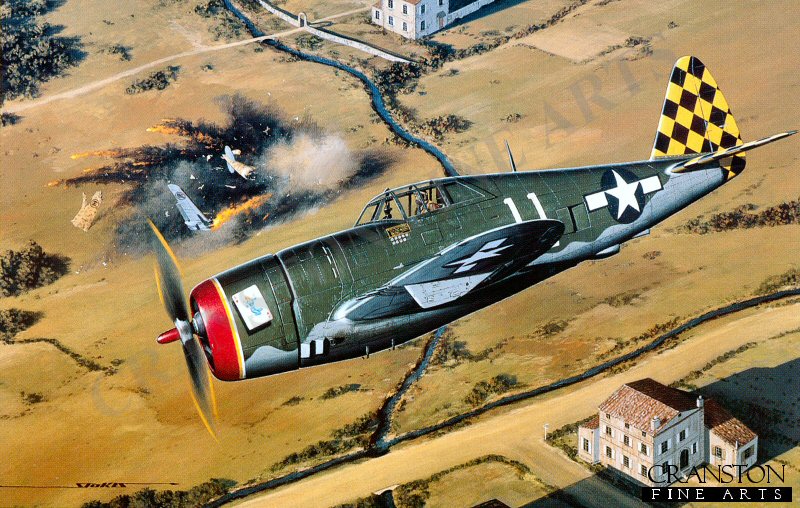- Sku:
- Vendor: Military Aviation Art Prints
Herky's Big Day by Stan Stokes.
The Republic P-47 Thunderbolt, or Jug7 as it was more popularly called, was the mount of many of the American aces of WW 11. The P-47 represented the crowning achievement from two aircraft designers, Alexander Kartvelli and Alexander De Seversky, both immigrants from Russia. It came on the heels of two other aircraft, the P-35 and P-43, which were satisfactory pre-war designs, but not up to the new standards required to compete against Bf-109 fighters in Europe or Mitsbushi Zeroes in the Pacific. The P-47 was the largest and heaviest single seat American fighter of the War. Powered by a huge 2000-HP radial engine, more than 15,000 Jugs were produced. The first production variant was the P-47B which had a razorback fuselage. During tests the aircraft attained a speed of 429-MPH with a maximum range at 10,000 feet of 835 miles. Later variants included a C and D model with the razorback fuselage. Belly tanks and wing tanks became standard equipment as the range of this fighter was stretched for bomber escort missions in Europe. In mid- 1943 one of the biggest pilot complaints about the aircraft was remedied when a bubble top canopy and redesigned fuselage was incorporated into the D model. This dramatically improved rearward vision of the pilots. These aircraft were armed with 8 machine guns, and could carry up to 2500 pounds of additional fuel or ordinance. Herschel Herky Green was one of the top USAAF aces in Europe with a total of 18 confirmed aerial victories (3 in P-40s, 10 in P-47s, and 5 in P-5 Is.) Green was born in 1920 in Mayfield, Kentucky. While studying mechanical engineering at Vanderbilt University he learned to fly in the Civilian Pilot Training Program. He joined the Army as an aviation cadet in 1941 and earned his wings an a commission at Foster Field in 1942. One of Greens first assignments was flying P40s in North Africa. He scored a total of three victories in P-40s before his squadron transitioned to the Jug. As depicted in Stan Stokes painting, appropriately entitled Herkys Big Day, Green downed six enemy aircraft on one mission over Northern Italy on January 30, 1944. Greens flight initially encountered a group of Ju-52 transports, and Green bagged four of them. About thirty minutes later the ace encountered a lone Macchi 202. In a low level turning duel Green eventually got in position and nailed the Italian fighter. Its wing dipped, caught the ground, and sent the Macchi into a terrible cartwheel of destruction. Heading home Green encountered a Do-217, which quickly became victim number 6. Green went on to later add four more P-47 victories, and after his group changed to the P-51 he scored an additional five, making him an ace in both the Jug and the Mustang. Green remained in the Air Force following the War, serving as Deputy Commander of the 4th Fighter Group at Selfridge Field. He also held a number of important staff positions prior to his retirement in 1964. Since that time he has been a successful businessman. Greens numerous decorations include the Distinguished Service Cross, Silver Star, Distinguished Flying Cross with Oak Leaf Cluster, the Purple Heart, The Air Medal with 25 Oak Leaf Clusters, and the French Croix de Guerre with Palm. Green resides in Southern California.
Only two prints of this edition remain.
Signed by P-47 Ace Herky Green (deceased).
Signed limited edition of 500 prints.
Size 22 inches x 18 inches (56cm x 446cm)
Have a question?

Herky's Big Day by Stan Stokes.


